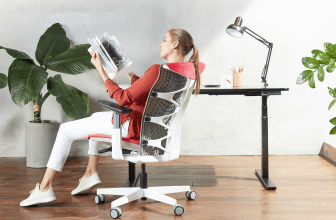If you’re sitting for long periods of time while working at home or the workplace, you’ll need an office chair that is both comfortable and effective at reducing muscle strain.
We’ll assist you in learning about how to choose an office chair in this post. Let’s take a look at this article of FittingChairs.
Reasons You Need a Great Office Chair
Let’s explore the main benefits of having one before finding out how to choose an office chair.
There are some of the reasons you should consider when choosing a great office chair.
- Creating your office environment more productive
Furnishing your office with ergonomic office chairs will encourage more effective teamwork. Team members who sit in a comfortable office chair will be able to focus more readily.
- Encouraging Good Posture
If you sit in an office chair that was badly made, you’ll be slouching and sitting in weird postures in no time, attempting to find a way to be more comfortable. Poor posture not only contributes to poor health but also has an impact on your office culture and team members.
The greatest office chairs will encourage better posture in your workforce while also lowering healthcare costs.
- Rewarding Your Team
Most office workers believe their office chair is uncomfortable, and more than half wish they could switch to a nicer chair. Your staffs want to feel at ease and happy at work.
Making your employees’ health a priority is one way to show them how much you value them. Investing in a good and comfy office chair demonstrates that you and your company care.
What are Important Office Chair Requirements?
Choosing an office chair might feel like a game of chance because you typically don’t know if you’ve made a good purchase until after a few years of use.
Today, it’s extremely tough, given the hundreds of various options available. Furthermore, each choice has a unique set of functionality and design elements.
Let’s look at a few requirements for selecting an office chair.
- Adjustable Height
This should be a standard feature in office chairs because it is so vital for maintaining good posture while working.
When working, the best seating position is for your legs to be parallel to the desk above you. You should be able to keep your knees almost at a straight angle while placing your feet flat on the floor.
With an adjustable height, you can easily move the chair into the position that is most comfortable for the individual or people using it.

- Reclining and Seat Adjustment
This should be a feature to give the person using the chair more personalization and comfort. Back support is provided by the recliner, while leg positioning is ensured by the adjustable seat, which works in tandem with the height.
These two are particularly helpful for relieving strain on the parts of the body that bear the brunt of your weight while seated.
- Armrests
Previously, many office chairs did not have armrests since they were considered a luxury feature, but people have realized that they have a functional use for office chairs.
When working at a desk, adjust the armrest so that your arms are straight on the keyboard.
Your hands and wrists have to do less work to reach the different keys when your arms are straight out across the keyboard. This reduces total wrist strain and the chance of developing disorders such as carpal tunnel syndrome.
How To Choose An Office Chair
Choosing a great office chair is not easy because there are a wide of factors that makes you consider it thoroughly. Through this guide of FittingChairs, you will learn about how to choose an office chair that provides good support to the various health problems and other benefits.
Let’s get started to discover how to choose an office chair!
- Tip 1: Type Of Office Chair
The first thing to consider about how to choose an office chair is the type of chair you want.
Here are some of the common types of office chairs you should consider.
Kneeling chairs
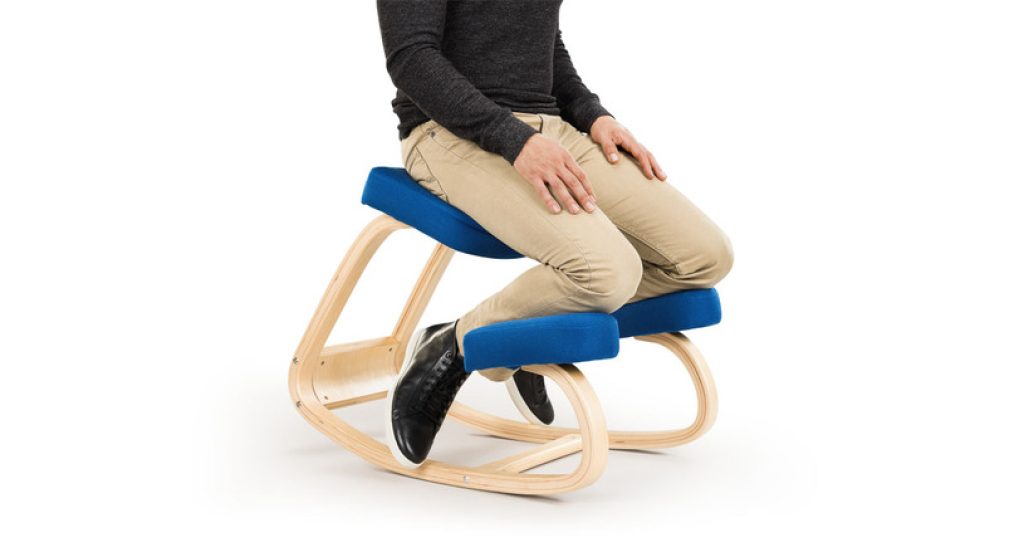
When you sit on a kneeling office chair, your knees are below your waist. Kneeling chairs do not have a back, your core and back muscles will progressively strengthen overtime to keep you stable while working.
The disadvantage is that if you already have knee problems, utilizing a kneeling chair may place undue strain on that area.
Ergonomic chairs
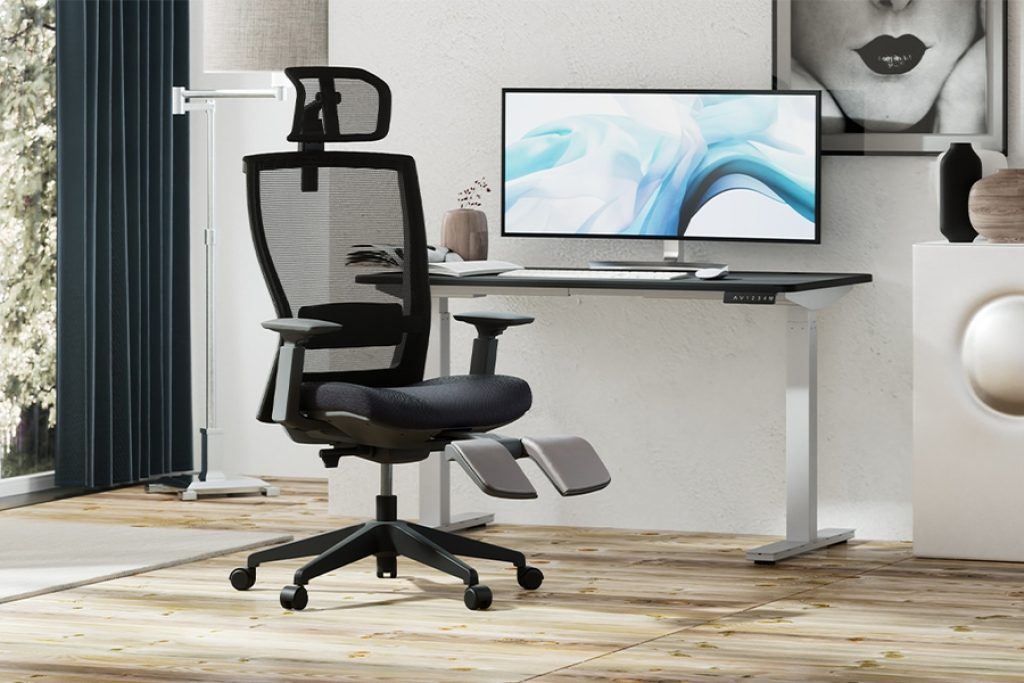
An ergonomic chair will help you enhance your posture by supporting your back. When shopping for an ergonomic chair, pay special attention to the qualities that are most important to you.
A chair with adjustable height, seat width, and depth is ideal. A tilting seat is also advantageous since it allows you to properly place your pelvis. Most chairs that claim to be ergonomic will have some lumbar support built-in.
Leather office chairs
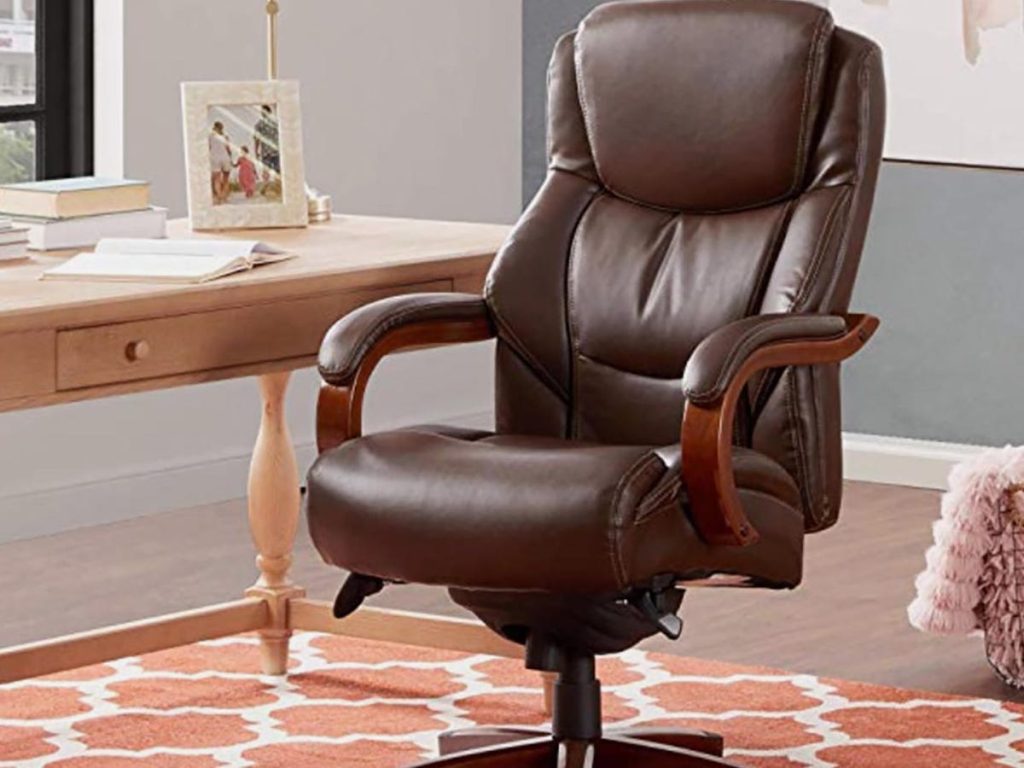
Consider investing in a leather chair to keep your office appearing attractive. The sheer number of leather office chairs available online might be overwhelming, so make sure you choose one with enough back support.
Mesh office chairs
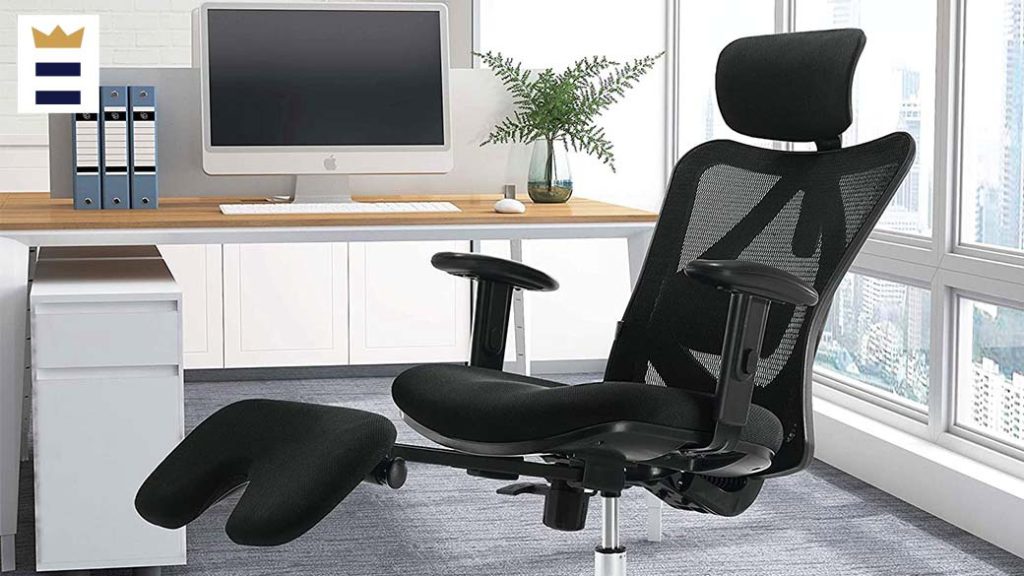
Mesh is stretched across the back of the chair, as opposed to a normal office chair with padded back support. Because it has more elasticity, this mesh is more breathable and better at adapting to the curve of your body.
You can alter the tightness of the mesh on some, which is useful if you want it to feel harder on your back.
Executive office chairs
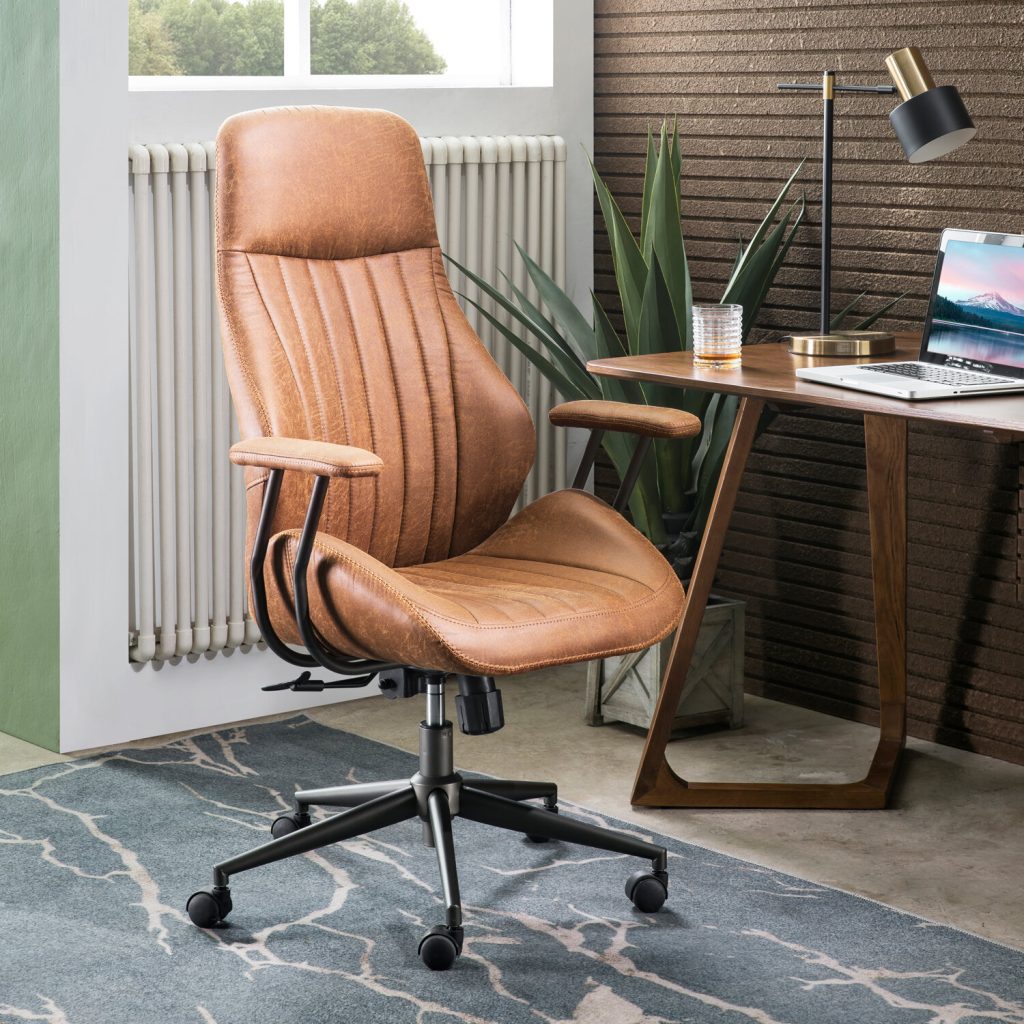
If you want to reward yourself with a luxurious chair that wouldn’t appear out of place in a chief executive’s office, this is the chair for you. These tall-backed chairs are intended to provide support throughout the complete upper body and are intended to be used for extended periods of time. The majority of them have wheels.
- Tip 2: Seat Height
The seat height of an office chair should be easily adjustable. The most convenient way is to use a pneumatic adjustment lever.
Most people can choose a seat height ranging from 16 to 21 inches off the floor. This allows the user to sit with your feet flat on the floor, thighs horizontal, and arms at the same height as the desk.
- Tip 3: Seat Width And Depth
The seat should be wide and deep enough to comfortably support any person.
The usual width is 17-20 inches. The seat depth should be sufficient for the user to sit with your back against the backrest of the ergonomic office chair while leaving roughly 2 to 4 inches between the back of the knees and the seat of the chair.
The seat’s forward or backward tilt should be adjustable.
- Tip 4: Lumbar Support
Lower back support is critical in an ergonomic chair. The lumbar spine has an inward curve, and sitting for long periods without support for this curve causes slouching and strains the lower spine tissues.
An ergonomic chair should include lumbar adjustment (both height and depth) so that each user can acquire the proper fit to support the lower back’s inward curve.
- Tip 5: Backrest Support
An ergonomic office chair’s backrest should be 12 to 19 inches wide. If the backrest is separate from the seat, it should be height and angle adjustable. It should be able to support the natural curve of the spine, with special care dedicated to good lumbar support.
If the seat and backrest are one piece, the backrest should be adjustable in forward and back angles, with a locking mechanism to prevent it from moving too far backward once the user has selected the optimum angle.
- Tip 6: Armrests Support
Purchase an office chair with armrests to relieve pressure on your neck and shoulders. The armrests should also be movable to let you may place them so that your arms rest comfortably while reducing your tendency to slump.
- Tip 7: Seat Material
The padding on the seat and back of the office chair should be sufficient to allow you to sit comfortably for lengthy periods of time. Breathable cloth fabric is preferred to a tougher surface.
How To Choose An Office Chair For Back Pain
Now, let’s move on to how to choose an office chair for those who want to reduce back pain. Let’s take a look!
- Choose a chair with good, solid back support. To help with support, it should be set up with no recline.
- Choose a chair that adjusts because it allows you to adjust not only the height of the backrest, but also the angle of the backrest.
- Choose a chair with no arms because they make it easier to move around and socialize.
- Choose a chair with lumbar support because it gives support for the lower back, preventing any tension that could develop to sciatica.
How To Choose An Office Chair For Neck and Shoulder Pain
Are you looking for an office chair for neck and shoulder pain? Look at some tips below:
- Choose a comfortable office chair with adequate armrests.
- Choose a chair with the appropriate backrest for your body type.
- Choose a chair with a back angle of 15 degrees.
- Choose a chair with the appropriate seat depth.
- Choose a seat height that enables your feet to rest comfortably on the ground.
- Choose a chair with headrest because it provides neck and head support while reducing shoulder strain.
Best Ergonomic Office Chair
An ergonomic office chair can help to alleviate lower back pain that can affect you long after you’ve left the office. Here are some of the highly-recommended ergonomic office chairs you should not hesitate.
How To Adjust The Right Office Chair Posture
Do you want to know how to adjust the right office chair posture if you are wondering your sitting posture is correct or not? Follow these above steps:
- Step 1: Sit deeply into your chair
Sit as deeply as you can in your chair, with your bum as far back as possible. If there isn’t a three-finger gap between the back of your knees and the edge of the chair, adjust the seat slide. Pull yourself into the desk; you want to be as near to the desk as possible.
- Step 2: Adjust your armrests
Relax your shoulders and take a deep breath. Your armrests should be adjusted to support your forearms. Your arms should not be ‘pushed up’ and should rest at a natural angle.
- Step 3: Sit at the right height
Adjust the height of your chair so that the armrests are level with the top of the desk. You’ll need a footrest if your feet don’t touch the floor when your arms are level with the desk. If you have a height-adjustable desk, use your armrests as a guide to raise or lower the desk.
- Step 4: Work effectively
The back of your chair can be locked or unlocked. We recommend unlocking the chair so you may make use of the mechanism and rock and move while sitting.
Raise your monitor or laptop so that the top of the screen or laptop is level with your eyebrows.
To avoid strained shoulders from over-reaching, keep your keyboard and mouse close by. To save your neck, if you utilize documents, raise it with a document holder and create extra desk space.
FAQs
Which brand office chair is best?
We highly recommend IKEA office chair because the ergonomics of them are excellent. Ikea’s office chairs have the majority of the necessary ergonomic features to improve the sitting experience while also increasing productivity and properly supporting users to prevent back problems.
In addition, you can consider other brands that also provide many health and comfort benefits such as Herman Miller, Steelcase, Branch Ergonomic Chair, and more.
How much should you spend on an office chair?
When it comes to office work chairs, there is no such thing as a one-size-fits-all chair. The cost of an office chair can range from $100 to $1500, depending on the build quality, adjustability, and other considerations.
A high-quality ergonomic chair with a 10-year warranty, customization possibilities, and at least four extra features should cost between $350 and $800.
Is it better to have an office chair with or without arms?
The chair with armrests provides more stability, which is beneficial for those who need to sit down. Those without physical concerns, on the other hand, should choose a seat without armrests because they make it easier to move around and socialize.
That’s all about how to choose an office chair you should keep in mind before buying a new one.
See more:
- Choosing the Best Office Chair for Neck Pain: A Complete Guide
- The 10 Best Ergonomic Office Chairs to Upgrade Your Home Office
- 10 Effective Ways of How to Make Office Chair More Comfortable
In conclusion, we’ve gone through how to choose an office chair by a step-by-step guide. Don’t forget to leave your comment in the below section if you have any questions for FittingChairs.



